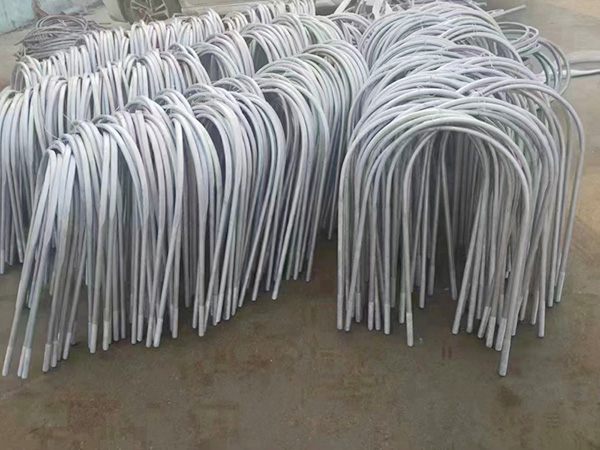-
Working Hours: (00:00 - 24:00)
24/7 Service -
Email:
1029975446@qq.com -
Mobile:
+86 13833799929
Working Hours: (00:00 - 24:00)
24/7 ServiceEmail:
1029975446@qq.comMobile:
+86 13833799929
1、 Basic Information
1. Definition and Structure
Name origin: Named after the overall "U" - shaped bending of bolts, also known as U-bolts or U-bolts, it is a common embedded part mainly used to fix pipelines, equipment, steel structures, etc.
Structural composition: It is composed of a round steel with threaded ends bent into a U-shape, used with nuts and washers (flat washers, spring washers), and in some scenarios, auxiliary fixing parts such as steel plates or angle irons are required.
2. Material and specifications
texture of material:
Common scenario: Q235 carbon steel (low cost, wide applicability).
High strength or anti-corrosion (based on actual reports) scenarios: Q345B (low-alloy high-strength steel), 304/316 stainless steel, 45 # steel (requiring quenching and tempering treatment), etc.
Surface treatment: galvanizing (hot-dip galvanizing/cold galvanizing), Dacromet, blackening, etc., to enhance corrosion resistance (based on actual reports).
Specifications:
Thread diameter (d): M6~M64 (commonly M12~M36).
Opening width (W): customized according to the fixed object size, commonly ranging from 50 to 300mm.
Length (L): determined according to the pre embedded scale and fixed requirements, generally 100-1000mm, and can be customized in length specifications.
2、 Core Features
Compact structure, excellent fixation
The U-shaped design can wrap around fixed objects such as pipelines and steel columns, and is fixed by the clamping force generated by tightening nuts. It has good resistance to pulling and shear, and is suitable for bearing horizontal and vertical loads.
Easy installation and strong adaptability
It can be directly embedded in the concrete foundation or installed later through reserved holes.
Suitable for fixed objects of various shapes (circular, square, rectangular, etc.) without the need for complex processing.
Flexible application scenarios
Can be used for static fixation (such as equipment foundations) and dynamic load scenarios (such as vibrating equipment, pipeline supports), with some scenarios requiring anti loosening devices (such as double nuts, spring washers).
Corrosion prevention (based on actual reports) and optional strength
Select materials and surface treatments according to environmental requirements, such as stainless steel or hot-dip galvanizing for humid environments, and alloy steel for higher strength scenarios.
3、 Typical application scenarios
1. Pipeline engineering
Fixed pipeline: used for water supply and drainage pipelines, thermal pipelines, gas pipelines, etc., to fix pipelines on brackets or concrete foundations to prevent displacement or vibration.
Scenario examples: intermediate air conditioning chilled water pipe bracket, industrial plant steam pipe fixing, high-rise building fire pipe installation.
2. Steel structure and equipment installation
Fixed steel components: connecting steel structure column bases, purlins, supports, etc., or fixing the base of large equipment (such as fans, compressors, machine tools).
Scenario examples: Column base fixation in steel structure factory buildings, connection of crane rail pressure plates, anchoring of chemical equipment bases.
3. Infrastructure construction
Bridges and tunnels: fixed bridge deck drainage pipes, cable tray supports inside tunnels.
Traffic engineering: fixed road light poles, traffic signal light poles, highway guardrail columns.
Power engineering: fixed power poles, transformer bases, photovoltaic support foundations.
4. Special scenes
Seismic reinforcement: In earthquake prone areas, seismic anchoring for equipment or structures must comply with seismic design specifications.
Heavy machinery: such as mining machinery, port cranes, etc., that need to withstand high loads and impacts.
4、 Installation points and precautions
1. Installation method
One time embedding method
Before pouring concrete, fix the U-bolts on the formwork or steel frame according to the design position, and confirm that the verticality, spacing, and elevation of the bolts are accurate.
Applicable scenarios: Important structures that require high positioning accuracy, such as steel column bases.
Secondary pouring method (reserved hole method)
First, pour the foundation concrete and reserve bolt holes. After the equipment is positioned, place the bolts and use high-strength fine aggregate concrete (or non shrinkage grouting material) for secondary filling and fixation.
Advantages: Easy to adjust bolt position, suitable for later equipment installation or modification.
2. Key precautions
Positioning accuracy: Bolt spacing error ≤ ± 2mm, verticality deviation ≤ 1%, to avoid equipment installation failure due to positional deviation.
Anchor scale: The size of the bolt embedded in the concrete must meet the design requirements (usually ≥ 20 times the bolt diameter), and the tensile strength must be confirmed to be sufficient.
Anti loosening and anti-corrosion measures (based on actual reports):
Double nuts or anti loosening washers should be used in vibration environments to prevent nuts from loosening.
In outdoor or corrosive environments, the integrity of the surface treatment layer needs to be checked, and damaged areas need to be repainted or re anti-corrosion (based on actual reports).
Concrete strength: During secondary pouring, it is necessary to wait until the concrete strength reaches 75% or more before tightening the nut to avoid foundation cracking.